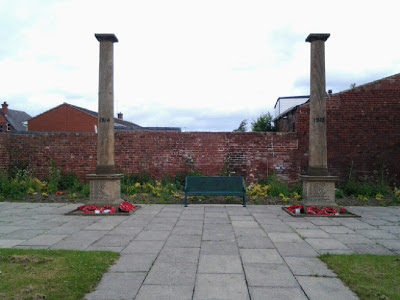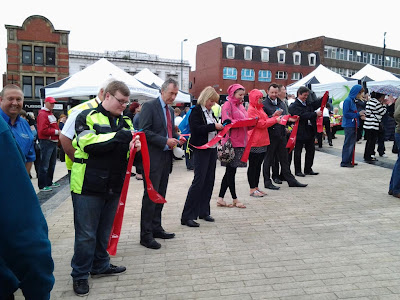I took nine photos with my Billion Graves app and once I'd checked them I uploaded them to the website. I tried linking all the photos together, but then found that when I unlinked them (to do a minor tweek) I deleted all the names I'd added so far. So I decided to leave them as separate images. Actually on the map you can see which images were taken of which pillar - the GPS is really very good.
 |
| Photo map of the pictures I took of Monk Bretton War Memorial |
In the Photo Map view of the Billion Graves website there's an indicator for each pillar and one for where I took the long shot I included in my last blog post. I have created Monk Bretton War Memorial as a cemetery in its own right - but as yet the photos still seem to think they were taken in Barnsley Cemetery ... I've emailed their tech support, but I think it's just a matter of waiting until they've approved the addition of the new cemetery and then the photos will 'know' where to go by their GPS tags.
In trying to find out more about Monk Bretton's War Memorial I have been Googling all morning and checking through my favourites for mentions of War Memorial sites. I wasn't getting anything for a local society - maybe they just haven't got a web presence, after all Local History Groups are all volunteer run and usually by older people, who may not have the skills to put together a web site.
Cudworth's War Memorial on the other hand produces lots of hits. The Barnsley Family History Society have a transcription of the names. A hit on the South Yorkshire Times site from 2003 describing how the Cudworth Local History Group successfully applied for money to refurbish the memorial. Their subsequent book, "Lest Cudworth Forgets" (Clark & Hayhoe) came out in 2005 and provides information on many of the names on the war memorial in St John's churchyard.
War Memorial Sites include 'Roll of Honour' which has good coverage for many parts of England, but not so much around Yorkshire unfortunately. It does include 77 different memorials for Yorkshire, which sounds like a lot until you compare that to Lincolnshire, for example, with 284 submissions. There is 'North East War Memorials' site which covers the area "between the Tweed and the Tees", I submitted information about my WW1 soldier James Nutley to this site a month or so ago having found a good picture of his memorial on there. The Imperial War Musuem has an online database of memorials, this site specialises in listing all memorials, no matter what their form. Their listing for Monk Bretton's War Memorial is factual and relevant, but does not include any names. I did however learn that the memorial in Monk Bretton is NOT in its original site, having been moved to the opposite side of the road at some point to facilitate work on an underground reservoir.
 |
| Monk Bretton War Memorial on its original site (from Yococo) |
A new site to me was the 'War Memorials Trust'. They are a charity which provides help and information to people who want to conserve their local memorial. On their home page was a link to 'War Memorials Online' a DIY site supported by the aforementioned War Memorials Trust and English Heritage which allows anyone to upload information about war memorials. Having the necessary information to hand I submitted my photos and a list of names to the site for the Monk Bretton War Memorial. You should be able to find my work here or by searching on the site.
It was very easy to use - I think I might go out and do the Cudworth Memorial later in the week - after all the more places a thing appears on the web the easier it is for people to find. With that in mind I am also sending my information to the Roll of Honour site by email.
Looks like I've found myself another project!









































